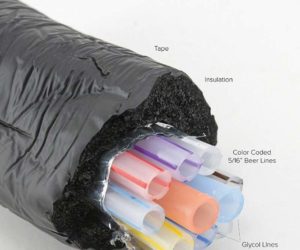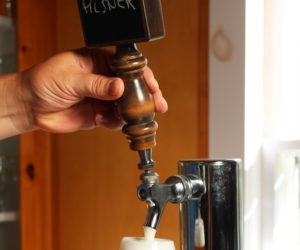Nitrogen Draft Tap
So you’ve got a kegerator, and you’re loving life now that you don’t have to bottle every batch of homebrew anymore. You also are the envy of family and friends because you serve finely crafted beer on draft in the comfort of your own home. But something is still missing: the ability to serve stouts, porters and pub ales with that same full mouthfeel, thick head, and gorgeous cascading bubble effect that your favorite brewpub or tavern offers with their fancy draft setup. With very little time and about $200 (if you are frugal, that is), you can serve up “nitro” beers at home without having to do any permanent modifications to your kegerator.
How does it work?
So where does that creamy mouthfeel, thick head and shimmering/cascading visual effect in a nitro beer come from? It’s a combination of two critical elements: a specially designed faucet and a special mixture of gas.
The faucet, which is often called a “stout” or “Guinness” faucet, sports an elongated vertical design and at its core has a restrictor plate that both slows down the speed of the pour and also agitates the beer as it is poured (which helps to create that big head). The restrictor plate, or “sparkler” as it is sometimes called, functions very similar to the aerator disc in a kitchen or bathroom sink faucet. It can also be removed from the faucet for a standard pour in cases where the faucet must serve double duty as both a stout and standard tap.
The other half of the equation is the gas pushing the beer, which is referred to as “beer gas,” “Guinness gas,” or even “beverage gas,” depending on the supplier. Nitrogen and CO2 blends are sold in a few different ways and it’s critical that you get the right blend for the below procedures to work. The blend you’ll want will have 70–75% N2 and 25–30% CO2. Avoid the common high pressure draft system 60/40 blend, which is actually 60% CO2 and 40% Nitrogen. Nitrogen does not dissolve very well in beer, and much of it comes out of solution almost immediately after pouring. This is a big part of what causes the visual cascading effect (the other part being the agitation from the restrictor plate in the faucet). Additionally, nitrogen tends to form smaller bubbles than CO2, and this is why a nitro-poured stout or pub ale has a dense, persistent head.
Once the pour is complete and the undissolved nitrogen has escaped, what’s left is a beer that’s approximately one-third as carbonated as a typical draft beer. In a nutshell, it’s similar to a cask ale but without the concerns of flavor degradation (oxidation) from pumping air into the keg. The lower carbonation also gives the beer a fuller mouthfeel as compared to beers served at higher carbonation levels.
Sourcing beer gas
Your current supplier of CO2 likely carries the nitrogen/CO2 gas mixture as well. If they do not, check with local bars and restaurants to find out where they get their gas. For various reasons, commercial draft systems frequently use a nitrogen/CO2 mixture to push all of the beers on tap—so if there is a place near you that serves draft beer, they’re getting the gas from somewhere. A polite inquiry with the manager will likely lead to a good supplier of beer gas. Also be aware that beer gas is sold in cubic feet and not in pounds as CO2 is sold.
Get the gear
Luckily, stout faucets use the same fittings as any other faucet, so there is no need for you to buy any additional shanks or draft tower fittings (unless, of course, you’re adding the stout faucet as an additional, permanent tap in your lineup). Stout faucets cost anywhere from about $75 up to about $150. I bought one of the cheaper models from www.beveragefactory.com, and it looks great and performs superbly. Most vendors that carry general kegging equipment will also stock stout faucets, so they should be easy to find.
As mentioned earlier, the restrictor plate can be removed, allowing you to use the stout faucet as a standard faucet. This makes things easier if you don’t plan to have a nitro-appropriate beer on tap at all times. Swapping out faucets when you switch kegs isn’t that big of a deal, but it’s one more thing to do and one more piece of gear to clean and put away. I had initially planned to change my faucet heads as I changed beers, but I’ve found that it’s much less of a hassle to just remove or reinsert the restrictor plate as needed.
Nitrogen is stored at a much higher pressure than CO2 and requires a different type of cylinder. In most cases it also has a female threaded connection, as opposed to a CO2 clyinder’s male connection. Check with your supplier as to the type of connection their cylinders have. Because of the higher pressure and different connection, you’ll also need a different regulator for the beer gas cylinder. An exception to this is if you already have a CO2 regulator that is rated up to the max PSI of the gas in your cylinder (generally about 3000 PSI), in which case you can use an inexpensive adapter to convert the gender of the regulator’s connection fitting. If you are not 100% certain about the regulator’s safety rating, buy a new regulator that meets the safety specs (which are usually stamped into the cylinder). You cannot make assumptions here. It’s not worth the risk of serious injury and/or major property damage to save a few bucks. If you plan to house the beer gas cylinder outside of your kegerator, it is imperative that you secure it with rope, chain, or bungee cables. A failed cylinder valve or regulator could create a serious problem that could injure bystanders and would almost certainly cause extensive damage.
Dispensing with beer gas
The most traditional way to go about serving your nitro brew is the traditional all-beer-gas method. This procedure works by simply taking your finished beer and hooking up the beer gas at about 30—35 PSI and lettting it carbonate for 7 to 14 days before serving. This is the same basic procedure you’d follow for carbonating with CO2. In order to pour a creamy pint with a thick and rich head it is very important to have less than 1.5 volumes of carbon dioxide in the beer and roughly 20 mg/L of dissolved nitrogen. In order to have that little carbon dioxide and that much nitrogen you must gas with mixed gas at a relatively high pressure. Too little nitrogen and you don’t have the nice foam and too much carbon dioxide and you end up with crazy beer when it is poured through a stout tap.
Because nitrogen does not liquefy at the pressures commonly seen in gas cylinders, it cannot be as densely packed as CO2 (which does liquefy at lower pressures). Therefore, even very large beer gas cylinders will generally be depleted far quicker than much smaller CO2 cylinders. And given that beer gas is more expensive than CO2, you’ll be making more trips to the gas supplier and spending more money if you decide to use this traditional method of carbonating your nitro brews.
“Faking” the nitro experience
If you don’t like the added expense and hassle of an additional gas cylinder and regulator, or if space constraints make them impossible to incorporate in your kegerator, there is a way to approximate the nitro pour experience without all of the additional equipment. You will still need, however, a tap faucet with a restrictor plate. Here is the basic procedure:
Hook up your uncarbonated (but well-conditioned) keg of homebrew to your CO2 tank and set the pressure to 15 PSI. Disconnect the CO2 and give the keg the decent shake for about 20 to 30 seconds. Reconnect the CO2 and lower the pressure to 10 PSI. Begin serving after 12 to 24 hours. When not serving beer for more than a couple of hours, close the gas shutoff valve to that keg, and partially vent the keg. This helps keep the beer at similar carbonation levels that you’d get with beer gas. It’s more work, and uses more CO2, but it does not require additional equipment. The resulting pour is similar to what you’d get with beer gas, but with a less impressive head and not as “big” of a mouthfeel. Still, the experience is quite a departure from the typical carbonation methods, and is a worthwhile experiment.
As a truly experimental alternative, try the above method but do not shut off the CO2 or vent the keg while not serving. This will give you a very nitro-like pouring experience for about two weeks, and then it finishes off as a traditionally carbonated beer. The downside is that as the beer gets more carbonated, the restrictor plate starts causing excessive head and it takes much longer to pour a full pint. But I’ve tried this twice, and I have enjoyed sampling the beer as it progresses from nitro-like to a more typical draft experience.
As always, experiment to your heart’s content, but please pay careful attention to good safety practices when working with gas under high pressure.



